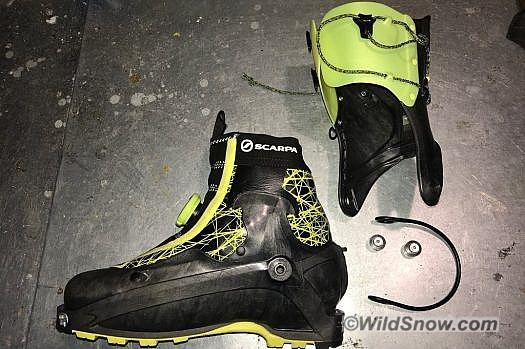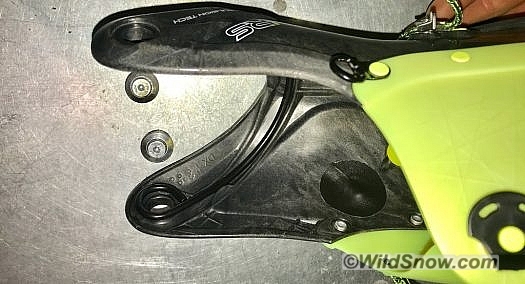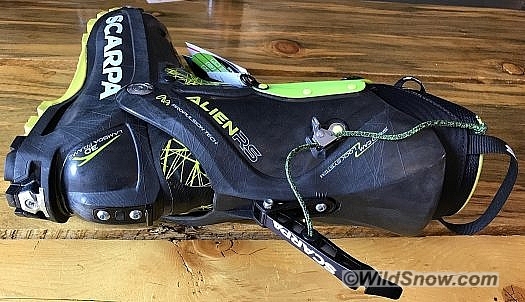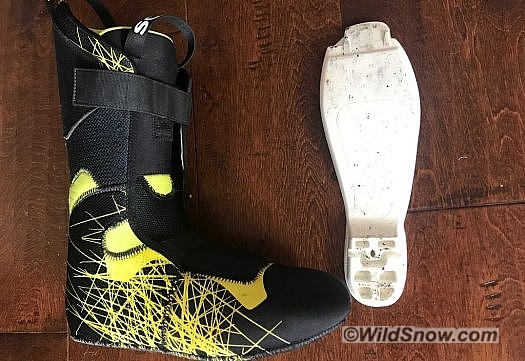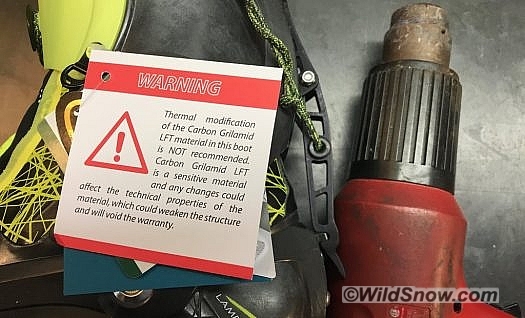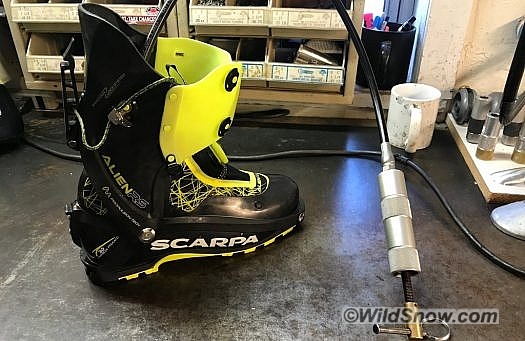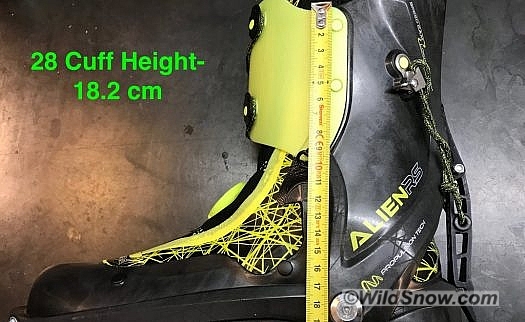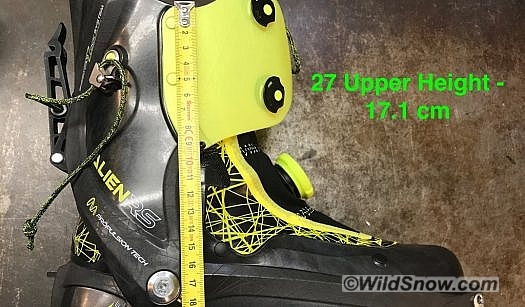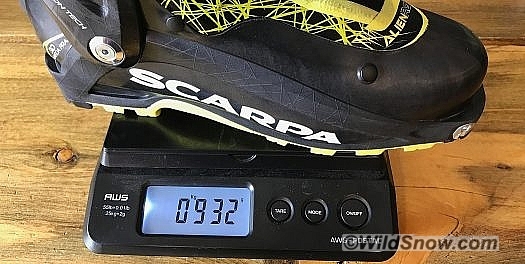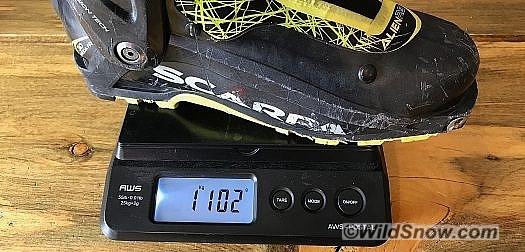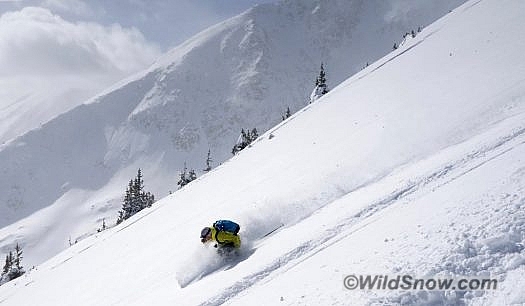
Yours truly in the Frankenalien driving 106 waisted skis. Lap 1 of a multi lap day up high in the Colorado alpine. Big days with modern gear, but anything can be improved.
There’s a growing segment of ski touring that is incredible to watch develop. From the many senders in Europe, to the Dorais bros in Utah, athletes are combining high levels of fitness, skiing ability, and featherweight gear to aggressively ski big remote lines from long distances, routes that often required overnighters in the not so distant past. The industry is watching and Scarpa has created the perfect boot for such rippers: Alien RS.
I’ve wanted to write a review for this boot since testing a pre-release version of it last spring, but felt the need to put it through the wringer first. Well now I have, and along the way have made some fairly aggressive modifications.
The RS is built in a two piece plus gaiter construction that is common among race boots. The plastic is Carbon Grilamid LFT, which is a new plastic Scarpa is using that reinforces ultralight and stiff Grilamid plastic with lighter and stiffer carbon fiber. The plastic is thickened in key areas in what Scarpa calls the 3D Lamda Torsion Frame. Further rigidity is added by a 3mm diameter steel bar that rests inside the bottom of the upper cuff and connects to both inner and outer cuff pivots. These pivots are small simple aluminum 3 piece units (bolt, nut, washer) that are removable with a hex wrench.
The upper and lower are latched together by a single simple throw that has multiple positions of attachment on the upper to give a forward lean adjustment of 7-13 degrees. Range of motion between these 2 pieces is a superhuman 73 degrees. Your ankle and foot are waterproofed by a gaiter that is welded to the lower shell, stays put with an elastic top with, and has a Boa dial smack in the middle of the top of the foot. Transitions stay true to the race heritage with a Dyneema cord closure tied in to the walk/ski lever. I have seen the knot in the cord behind its anchor point come free, but never an inline break in the cord. One downward throw of the rear lever tightens the cord across the cuff and said tightness is easily adjusted while in walk mode by a single toothed cam mechanism on the outside of the cuff.
Previous Aliens had a similar mode-change system but with only one length of cord crossing the shin, and an optional power strap. The RS uses two grabs on one side of the cuff to catch two loops coming from the other. This results in the cord crossing the shin 4 times over a 20 cm span that greatly increases snugness and eliminates (er, reduces) the need for a power strap.
Scarpa has always had good thing going in the co-developing of liners with the Canadians at Intuition. The Alien RS is no exception, with a stout and dense race weight Intuition liner. The liner is equipped with flex zones in the front and rear of the ankle and large pull straps on the rear and tongue. Very solid zones of unidentified material exist on the the top of the liner’s rear cuff and shin to diffuse the fore and aft pressure of the edges of the boot cuff. Another great race inspired feature is the velcro strap from liner cuff to tongue to opposite side. This keeps the tongue upright and centered for long periods in a very open walk mode. The boot board is a single piece of plastic which is easily removable for modification.
How about the fit?
Scarpa has traditionally shrunken the last in their ultra light boots, and the RS is no exception. Listed as a 99mm last, compared to the standard 101mm in all but the F1 (102mm), it is every bit that small feeling. Not only is the boot smaller laterally, but it has a slightly shorter feel as well. Simply put, it’s tight all the way around and Scarpa has done the downsizing for you on this one. Heel hold is quite good for a boot in this category, as you would expect from Scarpa, and the Boa snugs up the lower really well. I am a 27 on the dot on a mondo scale and ski 27 in Scarpa or 26.5 in other brands whose shell sizes break more traditionally.
I crammed my foot in the 27 test model for a few days but was wary of a full season of what would result in some sadistic version of Italian foot binding. When this season’s stock rolled in, I threw on a pair of 28’s and was seriously considering going that route. The foot was still tight laterally but in a “good” tight way only understood by skiers. The length though felt long and just looking at that “28.0” sticker was concerning.
The most noticeable difference however was the cuff height. The 28 cuff felt amazing. Similar to other taller alpine and AT boots I had been in, the added height really changed the feel of the flex in a positive way, giving more leverage to the ankle instead of pressure on the shin. After further investigation, the 28 and 29 share the same cuff as do the 26 and 27. This put me in an interesting spot being 6′ tall and feeling just between 27 and 28. Modding was the solution, see below. But first let’s conclude this review of the stock RS.
So how does it ski tour?
In my opinion the Alien RS blows away anything in its class on the downhill and in its ability to drive larger skis. Full carbon boots are quite stiff but give little to nothing in touch and feel throughout various turn shapes snow consistencies. Lightweight/race touring boots of the non-carbon variety generally will bottom out or have some lateral slop and struggle with any ski much larger than skimo race size boards. The RS has exceptional stiffness with a pretty good amount of feel through out that flex. The RS is also unbelievably stiff laterally.
This by no means makes the Alien RS ski like an alpine boot, or even like a heavier do-it-all touring boot. The flex is an acquired taste and demands a very intentional way of skiing. You have to be glued to the front of the boot with weight forward or you quickly get knocked in to the back seat. This is due to the more upright position and lack of alpine style progressive flex not only forward but in rebound as well. Or put another way, as soon as you let up a smidge, the boot snaps back to its non flexed position. The lower does open/deform under heavy loads (ie heavy snow, big skis, or high G turns) like most touring and some alpine boots do. Once you get a hang of light boot idiosyncrasies, the Alien RS absolutely rips and is a true engineering marvel. Transitions are as easy as it gets. One lever in a stock boot, and minor fiddling with an added strap and you’re off: up or down. As for walking, it doesn’t get much better. A sub kilo boot with more range of motion than the human ankle and a thin Intuition liner is as good as it gets.
Modifications: Commence Frankenbooting
Certain luxuries are afforded when you manage a backcountry ski shop. In addition to my six figure salary and unlimited access to the Cripple Creek Backcountry private helicopter (which I assure you is never used to gain otherwise human powered vert), I was able to construct the dream version of what was already my dream boot.
First the sizing dilemma. I ordered up a pair of both 27s and 28s with the intention of punching the heck out of the 27 lower to accommodate my foot, and then swapping the 27 upper for the taller 28 cuff. The only problem with this concoction is the traditional means of heating and stretching ski boots is inadvisable and will void the warranty of the Carbon Grillamid LFT boots.
Nonetheless, with care I was able to do four punches on my right and three on the left without damaging the boots. The plastic changed sheen with heat, and the big toe extension punch left a folded crease on top of the toe on booth boots. No holes, no cracks, no problems! My experience with punching this plastic was that I actually had to get it hotter and apply more pressure than standard Grillamid, Pebax or PU. Nerve wracking as this was, I was able to make ample room in the 27 shell where I needed it, and keep it snug where the 28 was not.
All this said, be mindful of the fact that getting a boot fitter (or ski shop manager) to punch boots such as this might be a losing proposition. For most skiers, if you know you’ll need punches it’s better to start with a standard Grillamid lower, which is quite easily heat molded. Ideally, we’d like to see reinforced Grillamid that’s as easily molded as the normal type. Judging from how rapidly ski boot technology is progressing, seeing that happen won’t be a surprise.
With a successful punch job, it was time to swap cuffs.
Prepare to go deep down the reasoning rabbit hole with me… the height of the size 26/27 cuff from center of pivot to low point of cuff is 17.1 cm, and 18.2 cm in the size 28/29. The height from below the heel to the center of the pivot in the size 27 lower is 8.1 cm versus 8.4 in the size 28. This gives the size 28 boot a 1.4 cm higher cuff than a size 27. This may (does) sound like an insanely obsessive thing to be concerned about, but it is actually quite noticeable. The Frankenalien would end up with a 1.1 cm taller cuff than a stock 27. If possible, move your power strap up a full centimeter on your boot and feel the difference. This swap maneuver did reduce the possible forward lean available by an amount that an MIT grad student would have to calculate. Mine is adjusted as forward as possible.
(Editor’s note from Lou: While I like the simplicity and elegance of this mod, A cuff height mod could also be accomplished by adding plastic here and there, if you don’t have another set of cuffs available.)
The actual swap is simple yet physically challenging due to the incredibly potent thread locking compound the cuff pivots are installed with. You’ll be happy to know that these babies aren’t coming undone on their own. After applying direct heat to the pivots with a lighter for 20 seconds each, I was able muscle the cuffs apart using the hex sockets provided on the inside nut and outside machine screw. I applied a little refresher of probably not as potent threadlocker, and slapped on the tall cuff. Done!
Further mods were less involved (and less expensive). As great as the liner is, I wanted a touch more give and play in the boot so I put a 27 Scarpa F1 liner in. This reduced the rigidity and stiffness feel just a fraction while making for a more snug ankle fit. The beefier F1 liner does inhibit the range of motion a touch. Next up, power strap. Ever since skiing with an original Booster Strap, I’ve been unable to like a boot without some sort of cam locking power strap squeezing the cuff around my lower leg. This is especially true of cord based closure systems where snugness is not generally a quality emphasized by manufacturers. I opted to drill two holes in the rear spoiler and bolt on a Salomon Quest/MTN Lab strap that is wide yet still reasonably light. Lastly, I have a green Superfeet insole and 3/4 length shim under the front of the liner. If I were to recommend any of these mods to try first, it would be the strap. And only for a non-race setting. I would honestly bet that a good solid strap would be just as noticeable as the cuff swap, if done in a scientific one-at-a-time manner.
I can hear you gram counters out there clinking away on your mental abaci. My modifications upped the boot weight to 1102 grams (gasp!) as compared to a stock 27 RS at 932 grams. I ski this boot hard with up to 106mm wide powder skis and in committed terrain and can 100% justify the added weight for the added performance. The key here is the combination of skiability and massive, minimally hindered range of motion. This nexus is not possible in an 800 gram boot any more than it is in a 1500 gram offering. For this combo to come in anywhere under 1300 grams is a steal. (Note: For those who prefer narrower skis, more conservative turn shape, or are just better skiers than I, a stock “sub one kilo” boot such as Alien RS will do the job, don’t obsess on modding, but…).
Conclusions:
Putting the whole package together, the Alien RS (modded or stock) represents the leading edge of what is happening in ski touring. These boots paired with lightweight and high performance skis and bindings are allowing for a new version of freeride speed touring. Early morning rises or overnight missions to slay one big line are becoming more casual starts to tours that tag that dream line and rip two more on the way back home. “I mean, we’re already out here aren’t we?” Or, “Whoa, let’s go ski that too!” The Alien RS would allow you to be competitive with all but the most elite rando racers out there, while doubling as a powerful boot to tackle the biggest of missions.
(WildSnow guest blogger Gary Smith is the Vail Cripple Creek Backcountry shop manager. He’s also an obsessive tinkerer of anything that supports his skiing addiction.)
On March 22nd 2021, Gary Smith tragically died in an avalanche outside of Beaver Creek Resort in Colorado. Since 2018, Gary has been a frequent and insightful contributor to WildSnow. From Christmas Eve spent at the Wildsnow Field HQ cabin, to testing gear and sharing his love for steep skiing around the world, he was a pillar of the ski touring community and will be greatly missed.

